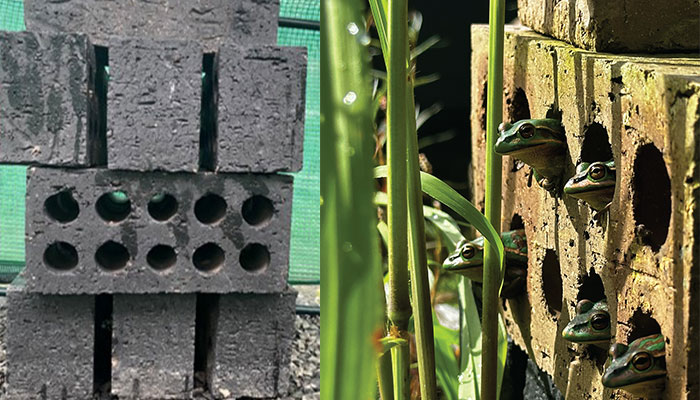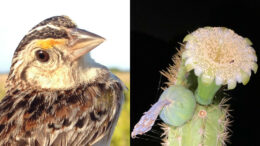Earlier this month I visited some friends at their home on the banks of the Columbia River — a house that could soon be under the Columbia River due to climate change and sea-level rise.
That same week we got news about Hurricane Beryl causing destructive floods around the United States, along with devastating floods in Brazil, India, China, and Kenya. Other floods this month caused destruction and fatalities in Liberia, Afghanistan, Indonesia, and several other U.S. states.
Is it any wonder that the sound of dripping water plunges me into a panic attack?
Welcome to Links From the Brink.
Best News of the Month:
When I last wrote about the Florida grasshopper sparrow (Ammodramus savannarum floridanus) in 2018, the critically endangered bird species had experienced a devastating population crash, leaving fewer than 100 individuals in the wild. As one conservationist told me at the time, “This is going to be North America’s next extinct bird if we do nothing.”
Well, we did do something. Some of the last birds were brought into captivity before they could die out, and even since then they’ve been breeding like there’s no tomorrow. As a result, they have a tomorrow. This month the Florida Fish and Wildlife Commission and partner organizations released their 1,000th captive-bred grasshopper sparrow into the wild. This seems to indicate that these rare birds have been saved from what just a few years ago seemed like an extinction in the making.
There’s a lesson in this amazing milestone: “These little birds represent a big beacon of hope that our commitment, partnership and holistic approach can save vulnerable wildlife from the brink of extinction,” as Fish and Wildlife Foundation of Florida president Andrew Walker told The Guardian.
Of course, all the captive breeding in the world can’t save a species if it has nowhere to live. Florida remains one of the most development-hungry places in the United States, and grasshopper sparrows’ habitat still needs protection and restoration. But 1,000 birds in six years is an amazing achievement, and it’s one worthy of celebration and emulation.
More Good News That May Have Fallen Through the Cracks:
Lynx from the brink: The Iberian lynx (Lynx pardinus), once critically endangered, has recovered thanks to decades of intense conservation effort. The IUCN last month reassessed the species as merely “vulnerable to extinction.” In 2005 the lynx population had fallen to an estimated 84 mature cats; the most recent count put them at a healthy (but still risky) 648.
The small predators benefitted from efforts to increase previously overhunted rabbit populations, which, once restored, finally gave the lynx plenty to eat and thrive. The IUCN warns, though, that another rabbit crash, a disease, or high mortality from roads could quickly undo this conservation victory.
Wolves: When wolves returned to Washington state in 2008, many hunters bemoaned that white-tail deer populations would suffer. Well, guess what — it didn’t happen. New research shows that wolves have had a minimal effect on deer in the Evergreen State — far below that of cougars (which also get a bad rap in WA) and habitat loss (i.e., development — the bane of communities throughout the West as people flock to this part of the country).
Meanwhile Washington rejected a push to remove state endangered-species status for wolves and lowered its previously lax cougar-hunting quotas to more sustainable levels. Conservationists praised both decisions. We imagine wolves and mountain lions were pretty happy, too.
Europe: After two years of debate, the European Union passed its Nature Restoration Law last month — which, according to news site Euractiv, “will set legally binding targets to restore 20% of the EU’s degraded land and sea ecosystems by 2030 and all ecosystems by 2050.” The bill got watered down a bit (farmers get a bit of a pass), but this seems like a good model for other 30×30 goals. (Speaking of which, six years is still a pretty tight deadline … )
Sued: A new report finds that the number of companies facing climate-related lawsuits keeps rising dramatically — and that most of these corporations are losing in court. Most of the recent lawsuits target so-called “climate-washing” — a willful misrepresentation of their progress toward promised climate goals. (The lessons: Lies cost you $$$.)
Fined: More losing: Marathon Oil just got socked with a $64.5 million fine for Clean Air Act violations at the Fort Berhold Indian Reservation in North Dakota, in the heart of the Bakken shale oil fields. The company must also pay another $177 million toward reducing its future emissions. General Motors, meanwhile, must pony up $146 million in fines because its vehicles emitted at least 10% more carbon dioxide than their compliance reports claimed. (Either of these items could actually go in the “bad news” category, since the spewing of greenhouse gasses and other pollutants went on so long before either company got caught and punished, but we’ll leave them in with the other wins for now as a warning to other gasbag corporations.)
Fined, part 2: French regulators this month fined conservative broadcaster CNews €20,000 (about $22,000) for allowing a pundit to spread climate skepticism (aka disinformation) without editorial follow-up or rebuttal.
I’ll admit, as an advocate of free speech and the free press, I have doubts about this approach to forcing balance from news outlets. For one thing, it seems the right wing could have weaponized this approach to water down good climate reporting if they’d come to power in France in this month’s narrowly won elections. Still, I’m intrigued and wonder if this could help stem the tide of further disinformation or if it will just cause pundits to double down on their lies. (Probably the latter, alas.)
Spa day: “Frog saunas” could help an endangered Australian species, the green and golden bell frog (Ranoidea aurea), recover from the deadly chytrid fungus, which has caused dozens of amphibian extinctions over the past few years. (This technique hasn’t proven helpful for other species, unfortunately.)

Vroom vroom: Another new report finds that rural families are saving thousands of dollars a year with electric vehicles. (Yes, these are the same rural families who many people assumed would resist transitioning away from gas-powered cars, trucks, and farm equipment. Shows what the “experts” know.)
Renewables: China is building twice as much renewable energy (specifically wind and solar) as every other country combined. (How do you say “This should light a fire under everyone else’s ass” in a carbon-neutral manner?)
(Seriously though, I don’t want to blindly praise China for this; its environmental record is terrible. But so is ours, so c’mon folks, catch up.)
And finally, a peak: Even fossil-fuel companies predict the world will hit peak oil demand next year. They see the writing on the wall (and the lawsuits in the wings?).
Worst News of the Month:
Getting back to that theme of flooding, the United States just lost its first species due to sea-level rise: the Key Largo tree cactus (Pilosocereus millspaughii).
Despite its geographically based monicker, this rare cactus grows on a handful of scattered islands in the Caribbean. But it’s no longer found in its namesake Key Largo — storm surges inundated the limestone outcrop where it once grew, increasing salt levels beyond what the plants could tolerate. The storms also washed away a lot of soil, which is kind of a basic need for plants.
It wasn’t just the salt water that caused problems. These cacti stored fresh water in their bodies, which then became a source of hydration for thirsty animals when the coasts became inundated with undrinkable sea water.
The cactus declined quickly amidst this one-two-three punch. In 2021 the Key Largo population — previously described as “thriving” — had deteriorated to just six stands. This month scientists announced that even those last individuals had disappeared.
But the species still exists on other islands, and scientists harvested the last Key Largo plants’ flowers and fruits in 2021 to cultivate them in a greenhouse setting. So far they’re doing fine, but the chance of replanting them in their native habitat appears slim.
This isn’t a full-on species extinction, but it is a local extinction caused by sea-level rise, the first of its kind identified to date in the United States. And it could be a portent of things to come, as botanist Jennifer Possley said in a press release: “Unfortunately, the Key Largo tree cactus may be a bellwether for how other low-lying coastal plants will respond to climate change.”
That said, I’m going to nudge this back into the “kinda-good” category, because at least scientists recognized the problem in time, saved what they could, and took the opportunity to warn us about future threats. That’s the type of proactive conservation that we should all aspire to and celebrate, even if it’s a part of the ongoing extinction crisis.
Bad News Quick Hits:
(Sorry. Let’s not dwell, but let’s not look away, either.)
-
- Chevron
- The Supreme Court in general
- Fiberglass in oysters and mussels
- 10.3 billion people by 2084?
- Protestors jailed
- Bitcoin = crashed power grids?
- The last ‘akikiki? (This breaks my heart.)
- Coal consumption could go up next year?
Quote of the Month:
“Inside your trash can is the possibility to change the world if you apply some creativity and some love. All trash is treasure.” — Troll artist Thomas Dambo, in The Washington Post
View this post on Instagram
That’s it for this edition of Links From the Brink. We’ll be back in a month or two with another roundup of under-the-radar news stories. Until then, keep an eye on the 2024 election, watch out for heat waves and wildfire smoke (not to mention floods), and check in on your neighbors in need (both human and wild).
Meanwhile, mark your calendars for International Owl Awareness Day on Aug. 4, World Krill Day on Aug. 11, Panamanian Golden Frog Day on Aug. 14, and (my favorite) International Orangutan Day on Aug. 19.
What will you be watching in the months ahead?




